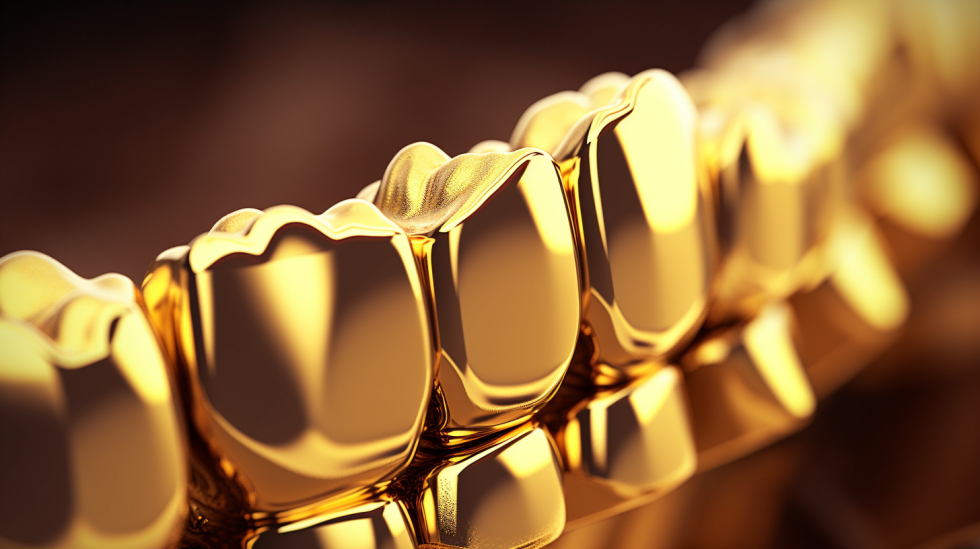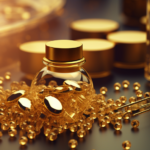When we think of gold, our minds often conjure images of dazzling jewelry, glittering coins, or prestigious awards. However, beyond these traditional associations, gold has been quietly revolutionizing another realm—the world of dentistry. For centuries, gold has been an integral part of dental care, and its unique properties make it invaluable in various dental applications. From fillings and crowns to orthodontic appliances, gold plays a vital role in preserving dental health and ensuring the longevity of beautiful smiles. In this exploration of “Gold in Dentistry,” we’ll delve into the fascinating ways in which this precious metal contributes to the field of oral healthcare.

Historical Uses of Gold in Dentistry
The use of gold in dentistry can be traced back to ancient civilizations. Gold was highly regarded for its durability and biocompatibility, making it an ideal material for dental applications.
1. Ancient Egypt: Historical records suggest that ancient Egyptians used gold wire to stabilize loose teeth. Gold was also used for dental restorations and ornaments.
2. Ancient Rome: The Romans were known to use gold in dentistry, particularly for tooth replacements. Archaeological findings have revealed gold crowns and dental bridges in ancient Roman remains.
3. Ancient India: Ayurvedic medicine, an ancient Indian healing system, recommended the use of gold in dentistry for toothaches and oral health.
Modern Applications of Gold in Dentistry
In modern dentistry, gold continues to shine as a versatile and durable material for various dental procedures. Here are some key ways in which gold is used:
1. Dental Restorations: Gold is used to create durable and long-lasting dental restorations, including inlays, onlays, and crowns. Gold restorations are known for their biocompatibility and resistance to wear.
2. Orthodontics: Gold is used in orthodontics to create appliances like braces and wires. It offers superior corrosion resistance and biocompatibility compared to other materials.
3. Partial Dentures: Gold is used to make partial dentures, which are removable dental prostheses that replace missing teeth. Gold alloys are chosen for their strength and resistance to corrosion.
4. Implant Abutments: In dental implant procedures, gold is used to create implant abutments, which connect the implant fixture to the crown. Gold abutments are known for their precision and durability.
5. Teeth inlays and Onlays: Gold inlays and onlays are custom-made restorations that fit precisely into a prepared tooth cavity. They provide excellent durability and a natural appearance.
Advantages of Gold in Dentistry
Gold’s unique properties make it an attractive choice for dental applications. Here are some of the key advantages:
1. Biocompatibility: Gold is biocompatible, meaning it is well-tolerated by the body and does not elicit adverse reactions. This makes it suitable for dental restorations and appliances.
2. Durability: Gold dental restorations and appliances are highly durable and resistant to wear and corrosion. They can last for decades, providing long-term value.
3. Precision: Gold can be cast into precise shapes, ensuring a perfect fit for dental restorations and orthodontic appliances.
4. Oral Health: Gold does not promote the growth of bacteria in the oral cavity, contributing to better oral health and preventing secondary dental issues.
5. Aesthetic Quality: Gold can be alloyed to achieve various shades, matching the color of natural teeth for restorations that blend seamlessly with the patient’s smile.
Gold in Dental Restorations
Dental restorations are procedures used to repair and replace damaged or missing teeth. Gold has a long history of use in dental restorations, and its unique properties continue to make it a preferred choice for certain applications.
1. Gold Crowns: Gold crowns are full tooth coverings used to restore severely damaged or weakened teeth. They are highly durable and provide excellent longevity.
2. Inlays and Onlays: Gold inlays and onlays are used to restore teeth with moderate damage. They are custom-made to fit precisely into the prepared tooth cavity and provide a natural appearance.
3. Gold Fillings: While less common today, gold fillings (also known as gold foil restorations) were once a popular choice for dental fillings. They are known for their durability and ability to withstand the forces of chewing.
Gold in Orthodontics
Orthodontics is the branch of dentistry that focuses on correcting misaligned teeth and jaws. Gold plays a crucial role in orthodontic appliances and braces.
1. Gold Braces: Gold braces are a popular choice for orthodontic treatment, offering both functionality and aesthetics. The brackets and wires used in gold braces are typically made of stainless steel coated with a layer of gold. This gold plating enhances the appearance of the braces and provides a touch of luxury to the orthodontic experience.
2. Retainers: Retainers are used after braces to maintain the alignment of teeth. Gold is often used for the wires in retainers due to its biocompatibility and corrosion resistance. Gold wires are comfortable to wear and less likely to cause irritation in the mouth.
3. Orthodontic Appliances: Various orthodontic appliances, such as expanders and headgear, incorporate gold components. Gold’s resistance to corrosion is crucial for these devices, which may be worn for an extended period.
Gold in Partial Dentures
Partial dentures are dental prostheses that replace missing teeth and restore oral function. Gold alloys are commonly used in the construction of partial dentures for several reasons:
1. Strength: Gold alloys are strong and can withstand the forces of chewing and biting. This ensures that partial dentures are durable and long-lasting.
2. Biocompatibility: Gold alloys are biocompatible, meaning they do not irritate oral tissues or cause allergic reactions. This is important for patient comfort and oral health.
3. Corrosion Resistance: Gold alloys do not corrode or tarnish in the oral environment, ensuring the longevity of partial dentures.
4. Aesthetics: Gold alloys can be customized to match the color of the patient’s natural teeth, providing a seamless and aesthetically pleasing result.
Gold in Dental Implants
Dental implants are a modern solution for replacing missing teeth. Gold is used in dental implant procedures for the creation of implant abutments, which connect the implant fixture to the crown. Here’s how gold contributes to dental implant success:
1. Biocompatibility: Gold abutments are biocompatible, ensuring that they are well-tolerated by the body and do not cause adverse reactions.
2. Precision: Gold can be cast into precise shapes, allowing for custom-made abutments that fit perfectly with the implant fixture and crown.
3. Strength: Gold abutments are strong and can withstand the forces of chewing and biting, providing stability to the implant restoration.
4. Longevity: Gold abutments are resistant to corrosion and wear, ensuring that they remain functional and reliable for many years.
Challenges and Considerations
While gold offers several advantages in dentistry, there are also considerations and challenges associated with its use:
1. Cost: Gold is a relatively expensive material compared to alternatives like porcelain or composite resin. This can affect the cost of dental procedures for patients.
2. Aesthetics: While gold restorations and appliances are highly durable, some patients may prefer more aesthetically pleasing options that mimic the appearance of natural teeth.
3. Availability: Not all dental practices offer gold restorations or appliances, so patients may need to seek out specialized providers.
4. Metal Allergies: Although rare, some individuals may be allergic to metals used in dental restorations. It’s essential for dentists to consider a patient’s medical history and allergies when recommending materials.
Future Directions
As dental technology continues to evolve, the role of gold in dentistry may see further developments and innovations. Here are some potential future directions:
1. Digital Dentistry: Advances in digital dentistry, including 3D printing and computer-aided design (CAD) technology, may lead to more precise and efficient methods of incorporating gold into dental restorations.
2. Customization: The ability to customize gold restorations to match the patient’s natural tooth color may become even more advanced, improving the aesthetics of gold dental work.
3. Biocompatible Alloys: Researchers may explore the development of biocompatible gold alloys with properties that further enhance their performance in dental applications.
4. Affordability: Efforts to make gold-based dental treatments more accessible and cost-effective for a broader range of patients may be explored.
Conclusion: A Golden Smile
Gold’s remarkable journey in the field of dentistry spans centuries, from ancient civilizations to modern dental practices. Its unique combination of biocompatibility, durability, and precision has earned it a respected place in the world of oral healthcare.
Whether used in dental restorations, orthodontic appliances, partial dentures, or implant abutments, gold continues to play a vital role in preserving dental health and enhancing the quality of life for countless individuals. It offers not only functionality but also the assurance of longevity and reliability.
As dentistry continues to evolve, so too will the ways in which gold is incorporated into dental procedures. Patients and practitioners alike can look forward to a future where gold-based treatments become even more precise, aesthetically pleasing, and accessible.
In the world of dentistry, gold is more than a precious metal; it is a symbol of durability, quality, and the pursuit of the perfect smile. It reminds us that oral healthcare is both an art and a science, where the timeless beauty of gold meets the modern advancements of dental technology.
So, the next time you flash a golden smile, remember that behind it lies not just the brilliance of a precious metal but also the craftsmanship and innovation that have made it a valuable asset in the world of dentistry.



